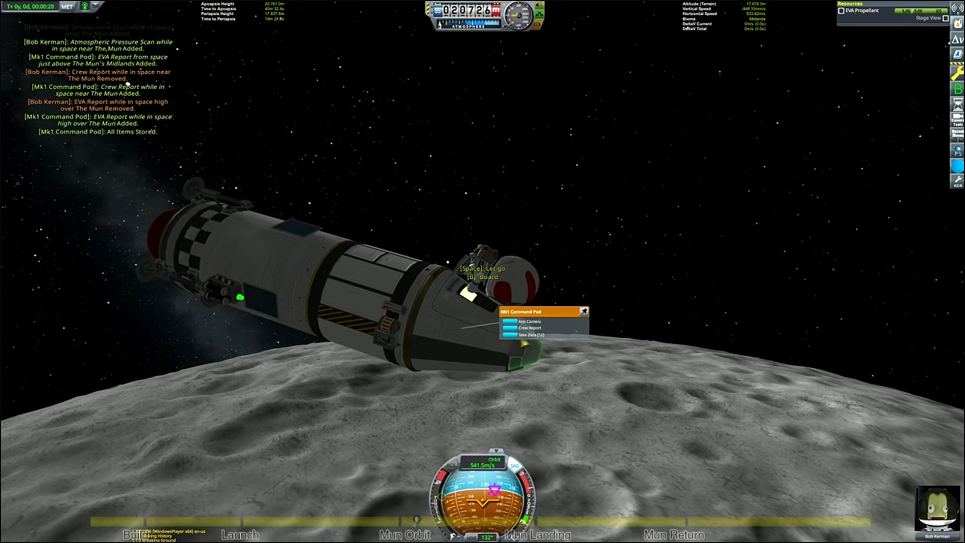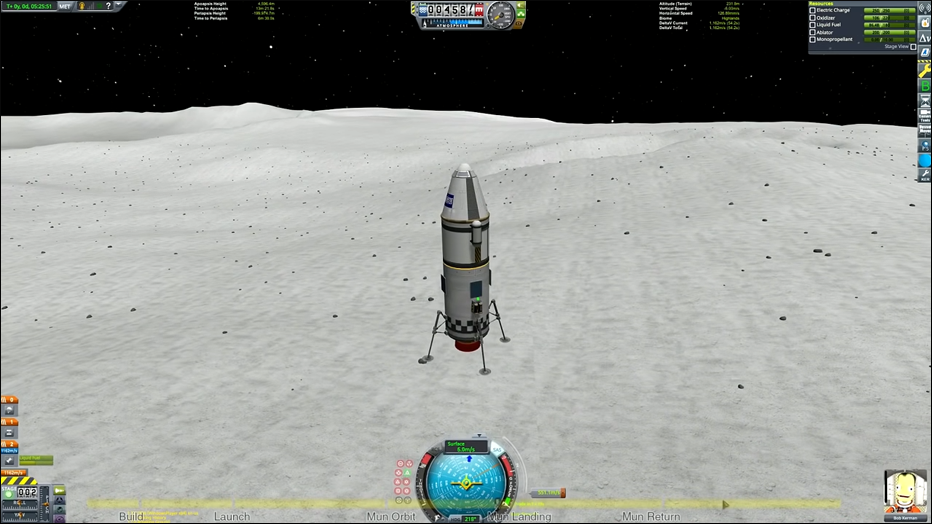As the long-awaited “Kerbal Space Program 2” approaches, fans of the original have flocked back to experience the joys of discovery and crashing hapless Kerbals into various celestial bodies. One of the primary objectives of the original game is getting to the moon (called “Mun” or “Mün” in the game), which is feasible if you apply real-life logic and have a multi-stage rocket built.

If you are new to the game or a bit rusty, we are here to help you get to Mun and back.
How to Land on Mun
You cannot aim straight for Mun and launch in hopes of getting there. The proper flight technique is very similar to how real-life lunar landings are performed. You start from a Kerbin orbit and move slowly into a Munar one, then start descending.
Designing a Munar Rocket
We will assume you are planning to safely travel to Mun and back (and save Kerbal lives in the process, as digital as they may be). You will need a multi-stage rocket to achieve this:
- The upper stage will be the Munar lander. It needs to land onto the Mun surface safely then fly back to Kerbin. Mun’s low gravity and lack of an atmosphere mean you need only a few fuel tanks and a thruster to make the return trip. You will need a parachute when landing on Kerbin.
- The middle stage is the transfer stage between Kerbin and Mun orbits. It typically means thrusters and more fuel cells to make the trip from Kerbin to Mun.
- The lower stage is your usual launch stage from Kerbin into its orbit. This stage will get detached as soon as you hit the Kerbin orbit, so plan accordingly.
Lift-Off!
After you have assembled a spaceship that can theoretically make the trip, here is how you fly to Mun and back:
- Launch the rocket and begin moving towards a stable orbit. You need to start tilting your spacecraft 10 degrees east (to achieve the same orbital direction as Mun) at around 100 m/s.

- Circularize your orbit between 70 and 150 km. That means you have to get your orbit periapsis and apoapsis to be the same. If you can not reach orbit at this stage, add more fuel to the rocket’s lower stage. Longer orbits mean you waste more fuel.

- Maintain free flight in Kerbin orbit, keeping an eye on the horizon.

- Once Mun rises on the horizon, begin a forward burn to widen your apoapsis until it reaches Mun’s orbit. Keep in mind that you are going for an extremely wide orbit, and only your apoapsis needs to reach the Mun. Use the time warp to pass the time after you have a correct path set.

- You can widen the apoapsis a bit over Mun to get better odds of getting caught in its gravity field.

- Once you have reached Mun, apply retroactive thrust to move into a Munar orbit below 200 km. Otherwise, you will escape into space.

- Pick a spot to touch down, then begin the descent. Remove any horizontal velocity by applying thrust until the yellow marker is on the Navball’s top. Eject the middle and lower stages if you have not done so already.

- Start slowing down by applying downward thrust at 50 km (50,000 m). Your velocity should be between 300 and 400 m/s at that point.

- Decrease the velocity below 10 m/s by the 10,000 m mark.

- Lower your landing gear at 2,000 m and kill any remaining horizontal velocity you have, then approach the Mun’s surface at 6 m/s or less. Aim for a flatter spot.
- You’ve landed on Mun!

- Start the trip back to Kerbin by burning your thrusters until you reach a 200 km orbit around Mun.

- Begin burning your thrusters prograde when you are moving opposite to Mun. That means that if you are orbiting the same way as Mun orbits Kerbin, start when you are between Mun and Kerbin. Otherwise, start when you are farthest from Kerbin.
- Create an orbit with a periapsis of 20 km or less from Kerbin, ensuring you get caught by its gravity and start landing eventually.

- Don’t forget proper Kerbin landing techniques and the parachute!

Mun Landing Is Tricky Business
It might take a few tries to land on Mun, but we are confident you can do it by following our guide. Just keep enough fuel on hand for all stages and keep your orbit’s dimensions in mind at all times. Good luck!
What’s your best Munar lander design? Let us know in the comment section below.











